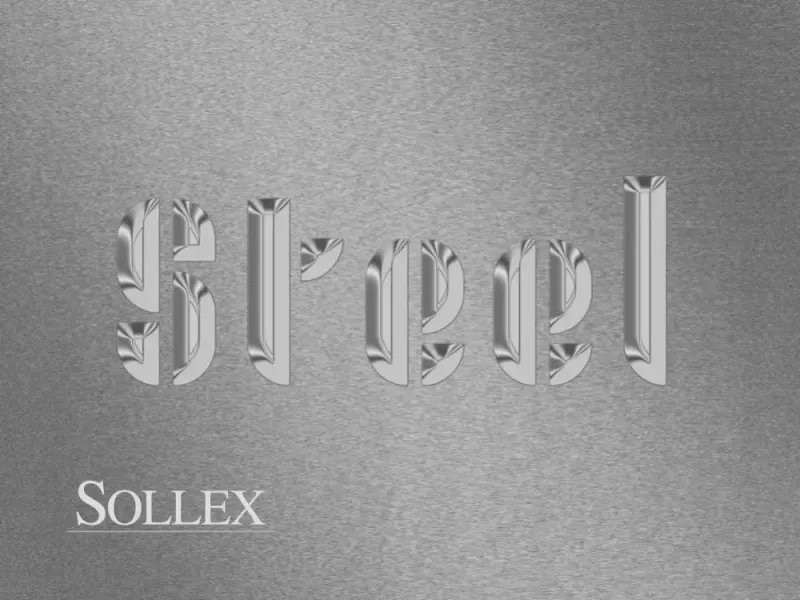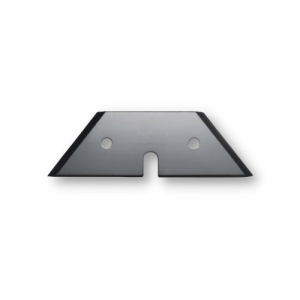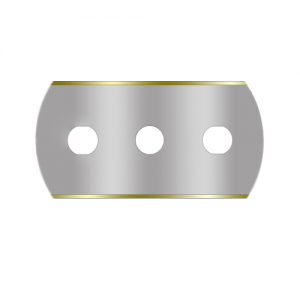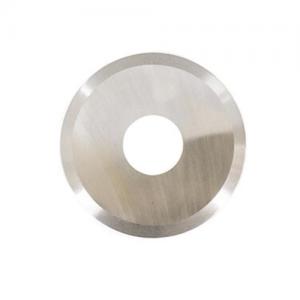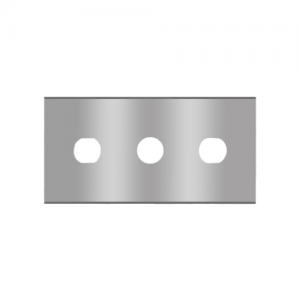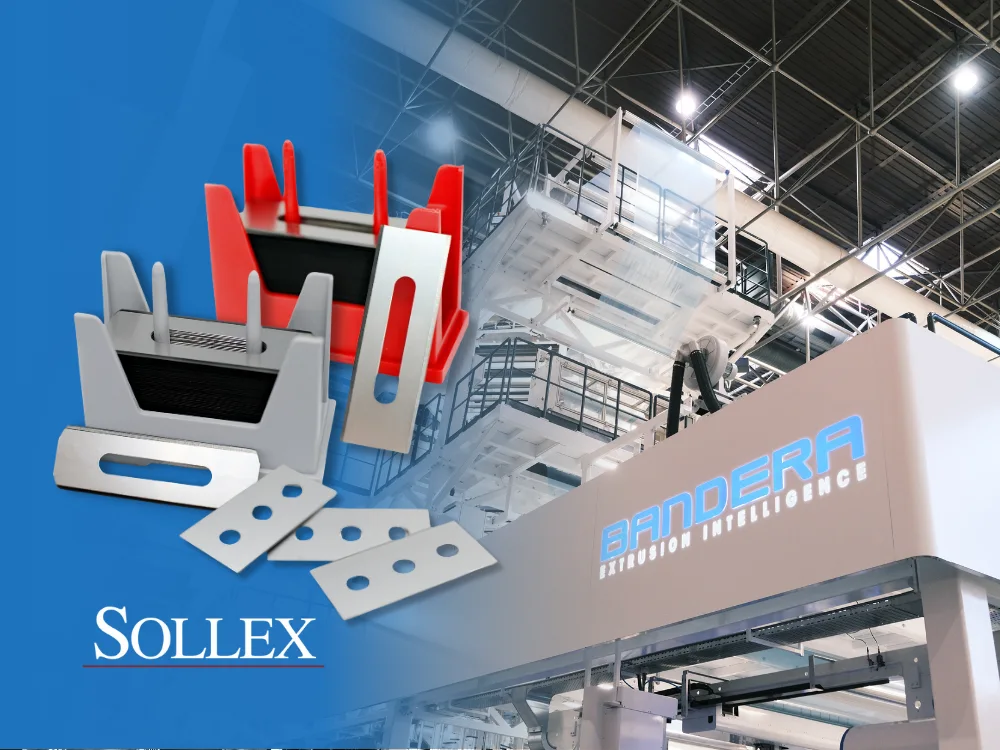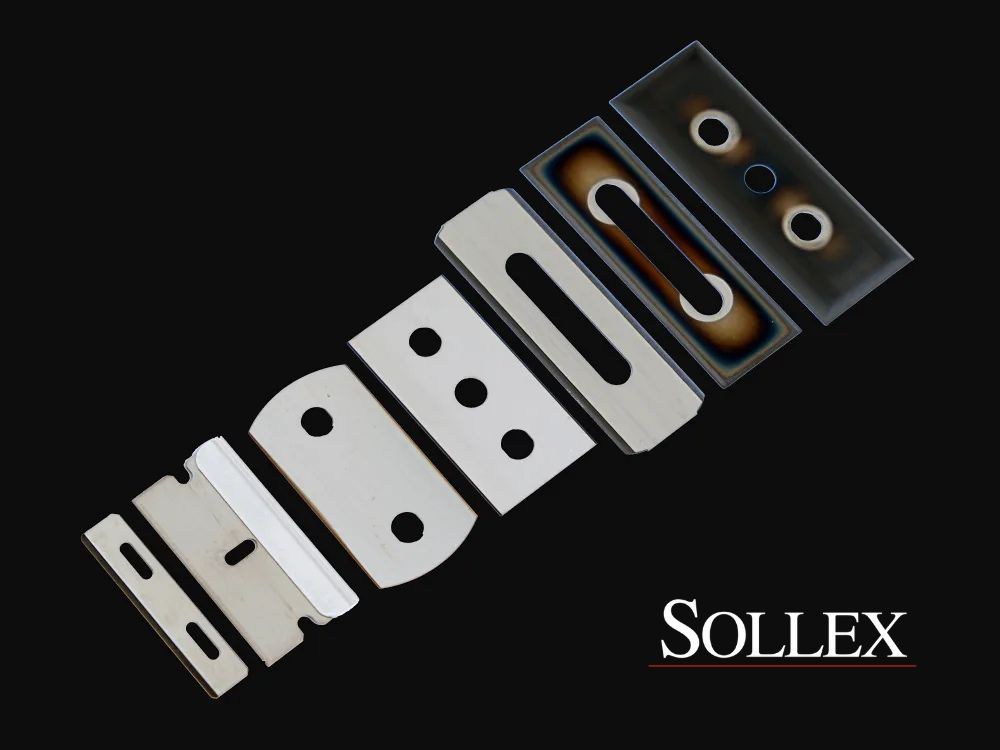Steel characteristics and coating of industrial knives
When selecting knives for industrial applications, you should understand and take into account the following indicators of the steel from which they are made: strength, toughness, wear resistance, edge resistance and stain resistance.
Content:
- Steel characteristics
- Types of materials used to manufacture machine knives and industrial razor blades
- Components of steel
- Extra coatings for use on industrial knives
Steel characteristics
Steel characteristics are properties that determine the behavior of the material and its suitability for various applications. Understanding these characteristics is critical to selecting the right type of steel for a specific purpose. Here are some key steel characteristics and why they are important.
Feature | Description |
|---|---|
Wear resistance | Wear resistance is the ability to resist abrasion. In general, the amount, type, and distribution of carbides in steel determine wear resistance. |
Strength | Strength is an ability to withstand loading without irreversible deformation. Every time something hard is cut or an edge is under lateral load, strength becomes a critical factor. In steels, strength correlates directly with hardness. Harder steel means stronger. Note that when measuring steel hardness with the Rockwell test, the hardness of the steel matrix is measured, not the carbides. |
Toughness | Toughness is an ability to withstand impact without damage, by which we mean chips, cracks, etc. and is obviously important for jobs such as chopping, but it is also important when the blade strikes harder impurities in the material being cut |
Stain resistance | Stain resistance (rust resistance) is an ability to resist oxidation. The more chromium bound in carbides, the less free chromium, which means more wear resistance but less stain resistance. Stainless steel is claimed to be the most stain resistant. |
Edge durability | Edge durability is a function of wear resistance, strength, and toughness. But different jobs require different edge holding properties. For example, when cutting cardboard, which often has hard inclusions, durability becomes extremely important because microspalls are often the cause of edge failure. |
Types of materials used to manufacture machine knives and industrial razor blades
Industrial razor blades are made from many different types of steel. Such as: non-stainless steels (carbon, alloy, and tool steels), stainless steel, titanium or even ceramics.
Sollex makes knives in the following materials: Carbon steel, stainless steel (SS), tool steel, HSS-M2 steel, D2 steel, hard tungsten carbide, and hard ceramic. Depending on your slitting process, we can design blades that will last longer and outperform wear-resistant materials.
Knife material | Characteristics |
|---|---|
Carbon steel | Carbon steel is a simple alloy of carbon and iron. 1084, 1095, etc. By definition alloying elements do not exceed the following limits: 1% Carbon, 0.6% Copper, 1.65% Manganese, 0.4% Phosphorus, 0.5% Silicon, and 0.05% Sulfur. Read more about carbon steel in our other article "Carbon steel for knives and razor blades". |
Tool steel | Tool steels are used in industrial applications for tooling. High speed steels HSS and high wear resistant steels are often examples of tool steels. Tool steels contain varying percentages of chemical elements such as tungsten, cobalt and molybdenum to adjust the heat resistance and durability of the steel. Products made of this type of steel are the easiest to handle, cut and drill. |
Stainless steel | Stainless steel is valued for its high corrosion resistance. The main element in stainless steels is chromium at about 10-20%. Stainless steel is about 200 times more resistant to corrosion than carbon steel. Stainless steel is much softer than carbon steel. Stainless steel is hard to regrind after hardening. |
HSS-M2 steel | The steel has a high edge resistance even under severe heat from friction, and is also characterized by high wear resistance. High-speed tools become quite brittle at high hardness, but with proper heat treatment, M4 works very well in large, heavy blades. M2 is a fast-cutting tool steel that has been around for a long time. Because M2 high-speed tool steel can retain its hardness even at very high temperatures, it is used in industry for high-temperature cutting. |
D2 steel | D2 is a semi-rusting tool steel. In composition it is almost stainless steel, which resists rust well, holds an edge well and has good strength. |
Tungsten carbide | Tungsten carbide is a composite metal containing mainly tungsten carbide, cobalt carbide, titanium carbide, and more. Tungsten significantly increases the hardness and heat resistance of the steel, but sharply reduces the impact toughness. Forming a tungsten steel product involves pressing a powder into a billet, and then heating in a furnace and sintering to a certain temperature, holding for a certain time, and then cooling to obtain the desired characteristics. Tungsten steel has a number of excellent properties such as high hardness, wear resistance, strength and toughness, good heat resistance, and corrosion resistance. Read more about tungsten carbide in our other article "Tungsten Carbide - Properties and Applications of Tungsten Carbide: Part 1". |
Ceramic | The ceramic material is based on zirconium dioxide processed by dry pressing and long firing.The zirconium oxide is pressed into ceramics under 300 tons of pressure. After that, the ceramic blade blanks are fired in a furnace. The firing temperature is 1400-1600 degrees Celsius. Firing of the blades can take 2-6 days. The longer the metal is baked in the oven, the more reliable and stronger it will be. Unlike metal knives, a ceramic blade is not susceptible to corrosion and does not require sharpening for a long time. |
Elements of steel
Below are the important steel alloys in alphabetical order and some examples of steels containing these alloys.
Chemical element | Specification |
|---|---|
Boron | Typical range in steel alloys is 0.0005 to 0.003%. Added to steel to improve hardenability. Most effective in low carbon steels. |
Carbon | Present in all steels and the most important strengthening element. It also increases the strength of steels but, in isolation, reduces toughness. |
Chromium | Added for wear resistance, hardenability and corrosion resistance. Steel with at least 13% chromium is usually considered "stainless", although by another definition. Adding chromium in large quantities reduces strength. Chromium is a carbide-building agent, so it increases wear resistance. |
Cobalt | Increases hardness, also allows for higher quenching temperatures. |
Copper | In large amounts detrimental to steel performance. Between 0.20% and 1% helps with preventing surface oxidation. |
Manganese | An important element, manganese contributes to grain structure and hardness. Also increases strength and wear resistance. |
Molybdenum | Forms carbides, prevents brittleness and maintains the strength of steel at high temperatures. Found in many steels, and air-hardened steels always contain 1% or more molybdenum. |
Nickel | Adds strength. It is widely believed that nickel also plays a role in corrosion resistance, but this is probably incorrect. |
Phosphorus | Found in small amounts in most steels, phosphorus is essentially a toughness-reducing contaminant. |
Silicon | Contributes to strength. Like manganese, it makes steel tougher to produce. |
Sulfur | Generally undesirable in cutlery steel, sulfur increases workability but reduces toughness. |
Titanium | Used to control grain size growth, which improves toughness. |
Tungsten | Includes carbides and increases wear resistance. When properly combined with chromium or molybdenum, tungsten turns the steel into a high speed steel. M2 high speed steel has a high tungsten content. |
Vanadium | Contributes to wear resistance and hardenability, and as a carbide builder (in fact, vanadium carbides are the hardest carbides) contributes to wear resistance. It also refines the grain of the steel, which promotes toughness and allows the blade to have a very sharp edge. |
Coatings for industrial knives
Steel quality defines how well a knife performs. Coatings on the blade can be used to change the characteristics of the cutting application. The edge coating on a blade acts as a protecter against the wear and tear of the material. Various coatings extend blade life and improve cut quality. As an added benefit, coatings can improve surface quality and reduce friction, which reduces heat and wear. Sollex offers following coatings to further enhance the performance of its products:
- Titanium Nitride (TiN) Coating of knife edges
- Fully titanium coated blades
- Ceramic coating of knife edges
- Fully ceramic coated blades
- Zero-friction coating
Read more about coating we offer on the page Guide about product qualities & coatings
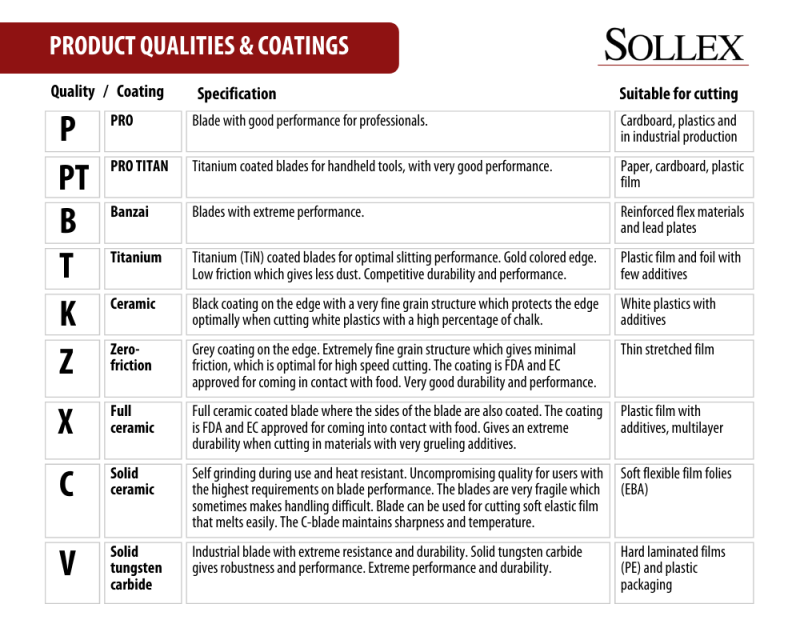
Common materials used for coating blades are titanium (-T), ceramic (-K), zero friction (-Z) and tungsten carbide (-V). Sollex ceramic-coated blades are FDA and EC approved, which means that they can come into contact with food.
If you are going to cut thin stretched film ( ex. LLDPE) with an automatic or semi-automatic wrapper, our Z-coating is perfect. For white plastic film (Poly film with additive chalk), Blades with K-coatings are a wise choice.
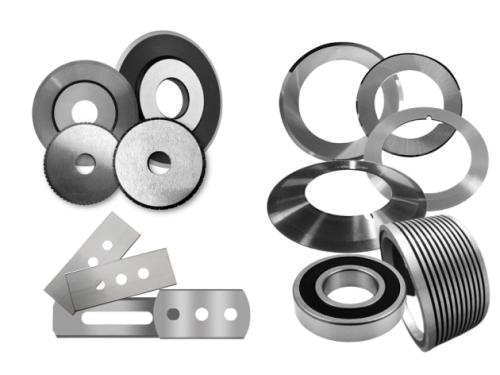
Sollex is a Swedish supplier of industrial knives and machine blades! We have cutting products with cutting-edge technology and performance that improve manufacturing and converting processes and solve problems. With the right knives and blades you can get simplified maintenance, time savings and an improved end product.
You are welcome to contact us with your questions:
Company name: Sollex AB
Customer service and orders: order@sollex.se
Telephone: +4635–15 75 00
Address: Box 5161, 200 71, Malmö, Sweden

